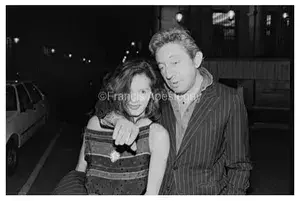Covering fifty years of celebrities caught in the lens, "Paparazzi! Photographers, stars and artists" considers the paparazzo at work by examining the complex and fascinating ties that form between photographer and photographed, going on to reveal the paparazzi influence on fashion photography.
By associating some of the genre's leading names, including Ron Galella, Pascal Rostain, Bruno Mouron, Tazio Secchiaroli, with reflections on this modern-day myth by Richard Avedon, Raymond Depardon, William Klein, Gerhard Richter, Cindy Sherman and Andy Warhol, "Paparazzi! Photographers, stars and artists" sets out to define the paparazzi aesthetic.
The exhibition is divided into five parts: Introduction, Photographers, Stars, Artists and Conclusion
1. RED CARPET (INTRODUCTION)
The visitor steps into the exhibition space to be immediately confronted with paparazzi flashes from an installation by Malachi Farrell, titled Interview (Paparazzi).
Photographs showing a pack of paparazzi "hunting their prey" create a mise en abyme that plunges the visitor into a new role as a star, while giving them a taste of the pressure celebrities are under.
Malachi Farrell - Interview
2. PHOTOGRAPHERS
The profession of paparazzo is more complex than it seems.
Paparazzi must be ingenious, mounting what are often delicate, high-risk operations. They each have their tricks of the trade and tales to tell which together form the grand story of "paparazzism".
In a series of interviews with paparazzi, a presentation of their tools (including spy cameras, long lenses and disguises), photographs by Francis Apesteguy, Olivier Mirguet, Jessica Dimmock and Christophe Beauregard, and an excerpt from Raymond Depardon's Reporters film, this section goes behind-the-scenes of the paparazzi.
Francis Apesteguy - Serge Gainsbourg
The figure of the paparazzo was invented by Federico Fellini in 1960.
The name is a contraction of "pappataci" (mosquitoes) and "ragazzi" (boys).
The paparazzo is portrayed as a post-modern anti-hero.
Since La Dolce Vita, he has become one of the mythical figures of popular culture.
Excerpts from films by Dario Argento, Federico Fellini, Brian De Palma, Louis Malle and Andrzej Zulawski, from the 1930s to the present, reveal the public's perception of the paparazzo as a solitary figure, often down on his luck.
Devoid of morals or scruples, and therefore hard to love, he is the double negative of the war correspondent.
3. STARS
Paparazzo is a male-dominated profession.
Its targets, on the other hand, are almost always epitomes of womanhood.
This section considers the case of eight women – Brigitte Bardot, Paris Hilton, Jackie Kennedy-Onassis, Stéphanie de Monaco, Britney Spears, Diana Spencer and Elizabeth Taylor – to show how the style and stakes of paparazzi photography have changed over half a century.
Ron Galella - Jackie Kennedy-Onassis and her husband
Celebrities are not just helpless victims.
When they spot the paparazzi, they can choose to play along with them and allow themselves to be photographed or not, in which case their reactions can range from a polite refusal to physical aggression.
They can also be a willing accomplice, going as far as to invent their own way of escaping the star system and its constraints.
This section presents celebrities' different reactions to the camera through a series of shots by the twentieth century's greatest paparazzi – Daniel Angeli, Francis Apesteguy, Ron Galella, Marcello Geppetti, Bruno Mouron and Pascal Rostain, Erich Salomon, Tazio Secchiaroli, Sébastien Valiela and Weegee.
Paul Schmulbach - Ron Galella and Marlon Brando, 1974
4. ARTISTS
The paparazzi photo has a recognisable aesthetic, a result of the conditions in which it is taken.
These are on-the-spot, improvised images, with all the consequences this has on their composition: the long lens for distance shots, or the flash for close-ups, flatten the image.
Celebrities shielding themselves behind their hand has become the symbol of media aggression.
Since the 1960s, the paparazzi aesthetic has inspired numerous artists in Pop Art, post-Modernism and more contemporary movements, from Richard Hamilton to Paul McCarthy, including Valerio Adami, Barbara Probst or Gerhard Richter.
Barbara Probst - Stills Gallery
Fascinated by the image hunters’ approach, numerous artists and fashion photographers since the 1960s have stepped into their shoes for one or other project.
Photographers such as Richard Avedon, William Klein and Terry Richardson were first to get under the paparazzo's skin for a series of shots.
Many artists, including the American Gary Lee Boas, English artist Alison Jackson, and G.R.A.M., an Austrian collective, have also collected stars in the same way paparazzi do.
Since the 1980s, women artists such as Malin Arnesson, Kathrin Günter and Cindy Sherman have questioned the artist's celebrity status.
Alison Jackson - The Queen
5. NEWSSTAND (CONCLUSION)
Celebrity magazines satisfy the demand of a media industry which has its own rhetoric and its own, unmistakable page layout.
Through works by Jonathan Horowitz, Armin Linke, Paul McCarthy and Andy Warhol, this last section raises the question of how paparazzi photos reach their audience.
Jean Pigozzi - Mick Jagger and Arnold Schwarzenegger, Hôtel du Cap, Antibes, 1990







No comments:
Post a Comment